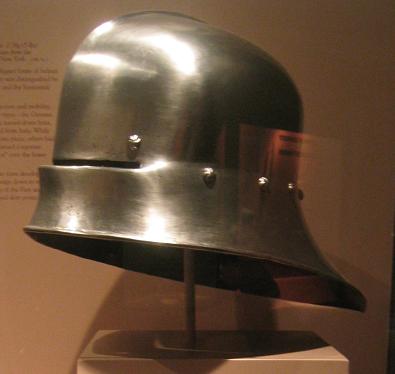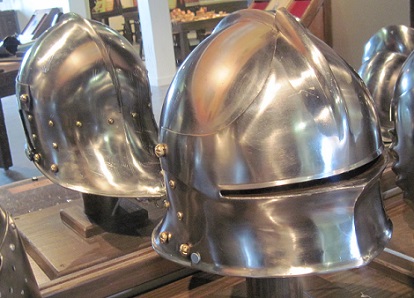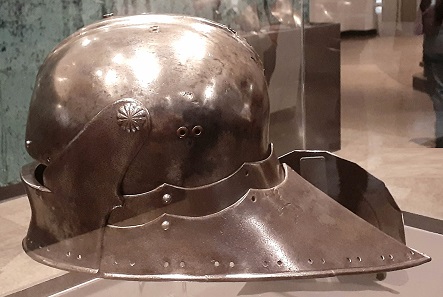Subject: Ritter knight
Culture: Imperial German
Setting: Holy Roman Empire, central Europe late 15thc
Object: Gothic armor
Higgins Armory Museum > Castle Quest *
* Metropolitan Museum of Art > Stone Gallery of Arms and Armor
"Composite Armor Steel Austrian (Innsbruck), comprehensively about 1485-95
The elements constituting this armor bear the marks of different armorers, all of whom were active in Innbruck in the 1480s and 1490s. The sallet is by Jörg Wagner (recorded 1485-1492), the breastplate and backplate by Hans Pruner (recorded 1482-1499), and the rondel by Kaspar Riederer (active 1455-1499). The elbow bears an effaced Innsbruck-style mark, while the left gauntlet is unmarked but of an Innsbruck type.
* Metropolitan Museum of Art > Stone Gallery of Arms and Armor
"Elements of an Armor Steel German or Austrian, about 1480-90
Few complete and homogeneous European armors have survived from the fifteenth century. This armor, produced at the peak of the German High Gothic period, is therefore important despite its fragmentary condition, because all of its remaining elements originally belonged together. Characteristic of armor worn in central Europe at this time are the separate defenses for the head and neck consisting of sallet and bevor; breastplate and backplate constructed of overlapping sections; and cusped and channeled surfaces. The backplate is notable for its elegant silhouette and fluted surface, imitating folds of fabric gathered at the waist.
Alcázar de Segovia *
* Metropolitan Museum of Art > Stone Gallery of Arms and Armor
"Sallet Steel, textile Kaspar Riederer (active 1455-1499) Austrian (Innsbruck), about 1480-90
The helmet comes from the armory of Churburg Castle in the South Tirol and was presumably made for the lord of the castle, Gaudenz von Matsch (before 1440-1504), count of Kirchberg. The original lining of padded fabric is preserved." ...
"Sallet of Emperor Maximilian I Steel, gilt copper Attributed to Lorenz Helmschmid (about 1445-1516) German (Augsburg), about 1495
This sallet was a new type probably invented by Lorenz Helmschmid for Emperor Maximilian I (reigned 1493-1519). Its construction, with the falling buffe (chin defense) pivoting on the same points as the visor, anticipates the appearance of the close helmet around 1510. The gilt fleur-de-lis trim, which originally bordered the entire helmet, is a typical late Gothic decoration that is found on several of the emperor's armors." ...
Alcázar de Segovia *
* Metropolitan Museum of Art > Stone Gallery of Arms and Armor
"Backplate Steel German or Austrian, about 1475-85 " ...
"Vamplate (Hand Guard for a Lance) Steel Matthes Deutsch (documented 1485-1495) German (Landshut), about 1490
The vamplate, for a lance used in the Scharfrennen (a joust fought on horseback with sharpened lances), has an upper plate designed to break away on impact, signaling to the judges and the audience a well-aimed hit." ...
"Sallet Steel Matthes Deutsch (documented 1485-1495) German (Landshut), about 1490
This sallet is unusually heavy (9 1/2 pounds). Therefore, it may have been intended for use in the joust rather than in the field." ...
Alcázar de Segovia *
* Alcázar de Segovia
"Armadura de guerra con celada a la alemana Estilo aleman de finales del s.XV" ...
Higgins Armory Museum *
"'Sallet' helmet, 1480-90 Southern Germany Steel Weight: 8 lb. 6 oz. ...
Full headgear like this provided outstanding protection for the head and neck,
at the cost of restricted vision. When the knight needed to look around,
the button catch at the right jaw allowed him to lift the visor.
Another button on the bevor allowed him to lower the mouthplate
so he could catch his breath and get something to drink."
"Bevor (chinguard), about 1500 Perhaps Spain Steel Weight: 12 oz." ...
* Arlington Museum of Art > A Knight's Tale
"Sallet German manufacture ca. 1500 Steel
This type of tournament helmet, known as a sallet, was used in Germany in a tournament game very similar to a joust. The contestants were knights armed with lances of war and protected by large shields screwed onto their cuirasses. The bottom portion of the face was protected by a chin guard. All variations of this type of helmet have the same long, pointed flange to the back to protect the neck. The rectangular slits on the front of the visor were used to secure the visor in an immovable position."
Alcázar de Segovia *
* Alcázar de Segovia
Royal Ontario Museum > Samuel European Galleries > Arms and Armor *
"Salade allemande Fabriquée d'un seul morceau d'acier. Poids: 2.3 kg. Allemagne méridionale, vers 1480. ...
La <<salade allemande>> était l'un des casques les plus rypiques et les plus élégants du XVe siècle. Elle se caractéisait, par une longue quéue effilée, par son ample tebord et, sur le devant, par une fente horizontale, pour la vue.
* Metropolitan Museum of Art > Stone Gallery of Arms and Armor
"Sallet Steel Attributed to Adrian Treytz the Elder (active 1466-1499)
Austrian (Innsbruck), about 1480" ...
"Breastplate
Steel German or Austrian, about 1475-85" ...
Higgins Armory Museum > Lobby *
"Visored sallet helmet with bevor
Nineteenth century manufacture after the 15th century manner of Lorenz Helmschmid of Augsburg, Germany" ...
Higgins Armory Museum > Castle Quest *
"Reproduction of a Sallet c. 1475"
* Higgins Armory Museum > Great Hall > Combat Wing
"Reproduction of the field armor of Archduke Siegmund of Austria, made 1911-19 (based on the original of 1485)
Germany (Munich)
Steel; brass; leather" ...
"Armor for a boar hound, 1942, after the German style of the 16th century
United States (New York)
Steel; iron; brass; leather" ...


